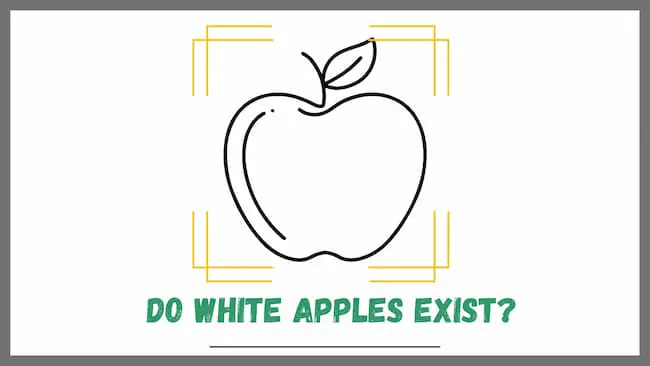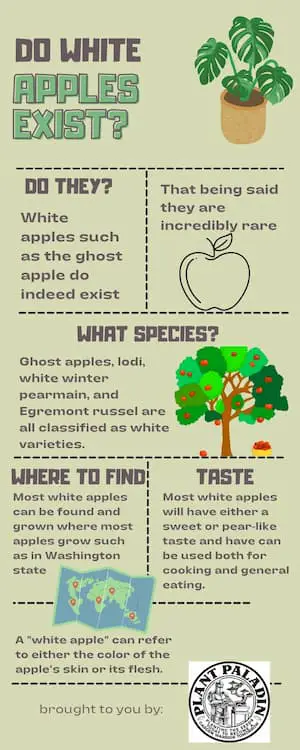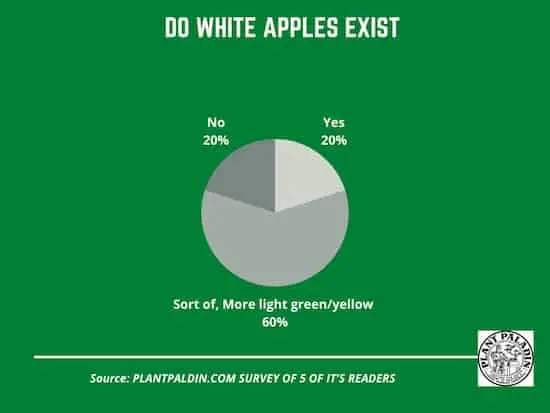This website is supported by its readers. If you click one of my links I may earn a commission. I am also a participant in the Amazon affiliates program and I will also earn a commission from qualified purchases.

So recently, I’ve considered expanding upon my apple tree collection from the gala and golden delicious trees I currently have. I’ve been reading up in a fair bit of detail about white apples and apple trees. So do white apples exist?
White apples do indeed exist. White apples, more commonly known as Ghost apples, have been created by Zaiger Genetics and contain white skin and inner flesh. These apples require warm temperatures to propagate.
So where can you find these white apples? And what do these ghost apples need to thrive? Keep reading to find out more!
Just a quick heads up, over the past three years of running Plantpaladin, hundreds of people have asked for product recommendations. As such, You can find my favorite indoor bonsai tree here (link takes you to Bonsaiboy), my favorite outdoor bonsai tree (link takes you to Bonsaiboy), or have a look at all the products I recommend here.
Do white apples exist?
To determine if white apples exist, I called up my local orchid, visited my local botanical gardens, spoke with experts, and surveyed a few plant paladin readers.
All to ensure you have the most informative, up-to-date post on if white apples exist.
To summarize:
- White apples do indeed exist.
- The most common white apple species has to be the ghost apple cultivated and created by Zaiger Genetics.
- Ghost apples then require warm temperatures, direct sunlight, and 500 chill hours below 45 degrees F to produce fruit yearly.
- These white apples are also non-self fruiting, meaning they need pollinating by other trees, most commonly Fuji Gala or granny smith apples.
- While Ghost apples have the best bang for your buck for white apples, other varieties include Russian heirloom varieties such as the yellow transparent and Lodi apples.
- That said, the whiteness of these apples will be nowhere near as bright as Ghost apples. These apples then tend to have a yellow/green tinge to them.
- Another well-known example is the White Transparent apple, which has a pale greenish-yellow or whitish skin when ripe. It is a summer apple variety typically tart and used for cooking or making applesauce.
- The White Winter Pearmain has pale yellow or white skin with a hint of pink or red blush.
- This apple variety is known for its sweet and slightly tangy flavor and is often enjoyed fresh or used in baking.
About the term white apples
It’s worth noting that the term “white apple” can also be used to describe apple varieties that have a pale or creamy flesh color rather than referring to skin color. Apples with white flesh include the White Pearmain and the White Winter Calville.
So, while white apples are not as common as red or green varieties, there are indeed apple cultivars that exhibit white or pale colors in their skin or flesh.
Let’s break down this information in more detail.

Are Ghost apples white?
So first up, ghost apples are indeed white.
The term ghost apple might be slightly confusing as it has often been referred to as a unique phenomenon during frost-like conditions.
We’re not talking about that.
Instead, we are talking about Zaiger Genetics ghost apples.
This company has managed to create what they call a Ghost apple.
These white apples then have white creamy off-white skin and white internal flesh.
These apples taste incredibly sweet and are not too acidic.
Now the downside is that these apples are scarce, with Zaiger Genetics being the only producer of these apples, according to my research.
These apples, however, are grown and adapted from regular Malus Domestica trees and will produce fruit in the summer.
Ghost Apple | Detail |
Color | Bright white/off green |
Skin | Slightly Ribbed |
Flavor | Sweet |
Uses | General cooking/consumption |
Self fruiting | No, fruit with other apple varieties such aas Gala, granny smith or pink lady. |
Fruiting | July |
Flowering | Spring |
USDA Zone | 10 |
Chill hours | 500 at 45 Degrees F |
Sunlight | 4 to 8 hours per day |
Location | Outdoor |
Watering | Once to twice per week, check if soil is dry before watering. |
Are Lodi apples white?
So next up, we have Lodi apples.
These varieties are large, slightly ribbed apples cultivated as replacements for the traditional Russian yellow transparent apples.
These apples are good for cooking and pies due to their often bitter taste.
Now these apples are either very light green or Yellow and, if ripe enough, can give an off-white appearance.
That said, the Ghost apple from Zaiger Genetics is likely to be far more white if you are interested in a genuine white apple.
Lodi apple | Description |
Color | Off white. yellow-green skin |
Flavor | Tart and acidic |
Uses | Excellent for cooking and applesauce |
Self Fruiting | No, fruit with other apple varieties such as Gala, granny smith, or pink lady. |
Fruiting | Early harvest, typically in June |
Flowering | Spring |
USDA Zone | 3-8 |
Chill Hours | 800-1000 at 45 degrees F |
Sunlight | Full sun 6 to 8 hours per day |
Location | Outdoors in apple-growing locations. |
Watering | Regular watering, well-drained soil. Water when soil is dry to the touch. |
What are the best white apples?
The best white apple has to be the Zaiger Genetics ghost apple. This apple produces a bright, creamy white skin and a fleshy white interior. This apple is also incredibly sweet, making it ideal for cooking and general consumption.
There are also several other white apple varieties; however the degree of whiteness is much less than ghost apples.
Instead, these apples tend to be light green or yellow, often passing as white apples.
- White Winter Pearmain: This apple has a sweet, aromatic flavor with a hint of tartness. It has creamy white flesh and pale yellow or white skin with a slightly pink or red blush.
- White Transparent: This early-season apple is known for its tart flavor and crisp texture. It has pale greenish-yellow or whitish skin when ripe and is often used for cooking or making applesauce.
- White Sweetheart: This apple has a sweet and juicy flavor with a hint of pear-like notes. It has pale yellow or greenish-white skin with a slightly pink or red blush and is popular for fresh eating.
- White Winter Calville: This apple variety has a crisp, creamy white flesh and a slightly tangy flavor. It has pale yellow or greenish-white skin with some red or pink streaks.
- Egremont Russet: While not entirely white, this apple has a pale yellow or greenish-yellow skin with a russet texture. It has a rich, nutty flavor and is often considered among the best russet apples.
Are white apples rare?
True white apples with clean white skin and a white flesh interior are scarce, with only Zapier genetics ghost apple being the only one available for consumption.
While plenty of other light-skinned off-green and yellow apples are on the market, such as the white winter caville apple, most of them have hints of other colors.
As such, finding an actual white apple is very uncommon.
Where are white apples found?
True white apples, such as Zapier Genetics ghost apple, can only be purchased directly from them.
Other White apples or apples classified as off-white can be found in various apple-growing regions worldwide.
The specific availability of white apple varieties may depend on different regions’ climates and agricultural practices. Here are some general areas where white apples are grown:
- United States: White apples, such as the White Winter Pearmain and White Transparent, can be found in apple-growing regions throughout the United States, including states like Washington, New York, Michigan, and Oregon.
- Europe: Several white apple varieties are grown in Europe. Countries like France, England, Germany, and Italy cultivate white apples like the White Pearmain, White Winter Calville, and Egremont Russet.
- Canada: Canadian provinces like Ontario and British Columbia are known for apple production, and white apple varieties are grown in these regions.
- New Zealand: New Zealand is a significant apple-growing country, and it produces white apple varieties like the White Winter Pearmain and other cultivars suited to its climate.
- Other regions: White apples can also be found in apple-growing regions of countries like Australia, South Africa, and Chile.
What do white apples taste like?
The white ghost apple has a Sweet sub-acidic flavor, making it ideal for general consumption and cooking.
The taste of other white apples can vary depending on the specific variety. Still, they generally offer a range of flavors that can be sweet, tart, or combined. Here are some typical flavor profiles associated with white apples:
- Sweet and aromatic: Some white apple varieties have a pleasantly sweet flavor with hints of floral or honey-like notes. These apples often have a delicate, mild sweetness that is enjoyable for fresh eating.
- Tart and tangy: Certain white apple varieties may exhibit a tart or tangy flavor profile. These apples can provide a refreshing and zesty taste with a balance of acidity and sweetness. They are often used in cooking or baking to add a tart element.
- Subtle pear-like notes: Some white apples have a subtle taste reminiscent of pears. This can add an exciting layer of flavor, providing a hint of fruity sweetness and the apple’s natural characteristics.
- Nutty undertones: Certain white apples, particularly those with a russet texture like the Egremont Russet, may have a unique nutty flavor. This adds complexity to the overall taste experience and can be distinctive.
What is a white apple?
A “white apple” can refer to either the color of the apple’s skin or its flesh. Here’s an overview of both meanings:
- White-Skinned Apples: These are apple varieties that have white or pale-colored skin. Examples of white-skinned apple varieties include the White Transparent, White Winter Pearmain, and SnowSweet. The color of the skin can range from pale greenish-yellow to whitish with hints of pink or red blush.
- White-Fleshed Apples: These are apple varieties that have white or creamy-colored flesh. Examples of white-fleshed apple varieties include the White Pearmain, White Winter Calville, and White Sweetheart. The flesh of these apples tends to be pale or creamy white, unlike the more common yellow or greenish-white flesh found in many apple varieties.
It’s worth noting that the term “white apple” is not a specific apple variety but rather a description of the apple’s color. Several apple cultivars exhibit white skin or flesh, each with unique flavor, texture, and characteristics.
Do white bonsai apple trees exist?
Apple bonsai trees that produce white apples are not currently available in the marketplace. If you want your bonsai tree to produce white apples, you must grow from the seed of a ghost apple tree.
Survey results
Finally, I wanted to ask five plant paladin readers if white apples existed.
One of my big surprises was that because of the rarity of the ghost apples, the participants were convinced that most apples were off-white and had yellow/green tints.

My top picks for the gear you will need!
So like I mentioned earlier, over the past three years of running PlantPaladin, hundreds of people have asked me for my recommendations on the best bonsai gear on the market.
Having spent thousands of dollars on bonsai items these past few years and tested at least 100 bonsai-specific products, I’ve listed my favorite products below – All of which I highly recommend and think you can get great value.
They can purchase directly by clicking the link to take them to Amazon.
Bonsai Tool Set: One of the significant challenges I’ve had is finding a toolset that was not only durable but didn’t break the bank. SOLIGT has recently developed a fantastic bonsai tool set that covers all the tools you need to trim, prune, and repot your trees. – You can grab it here.
Complete Bonsai Set: Many of you will want to grow your bonsai trees entirely from scratch, but finding the varicose seeds, pots, and other items in one place can be challenging. Leaves and Sole then have created a complete bonsai set that I’ve personally used that ticks all the boxes. You can grab it here.
Bonsai wire: The number of times I’ve run out of wire for my bonsai or purchased cheap bonsai wire that doesn’t do the job is embarrassing for me to admit. After a lot of trial and error, I found that using Hotop’s aluminum bonsai wire is one of the best options on the market. This can easily be used for both indoor and outdoor bonsai. You can grab it here.
